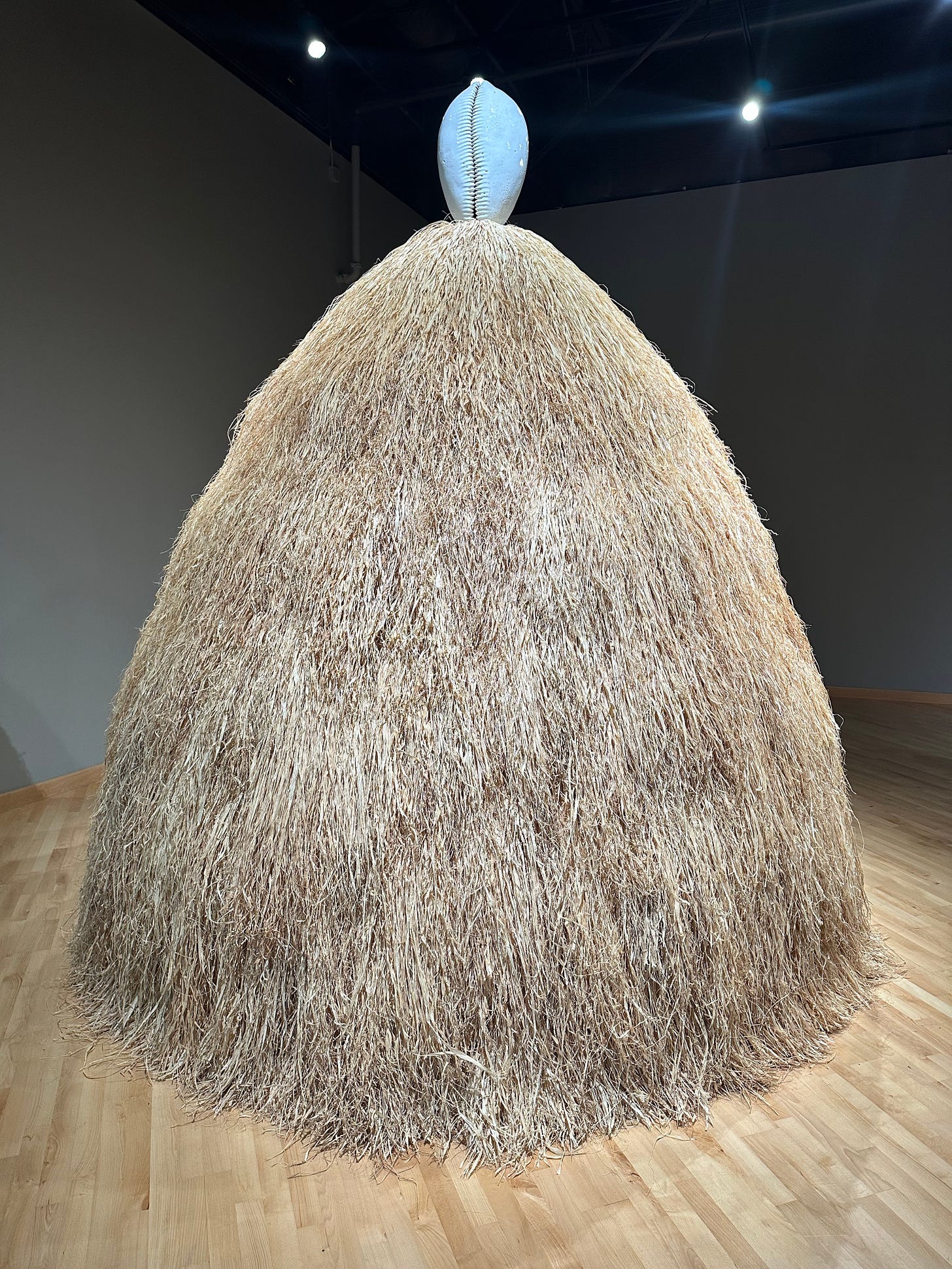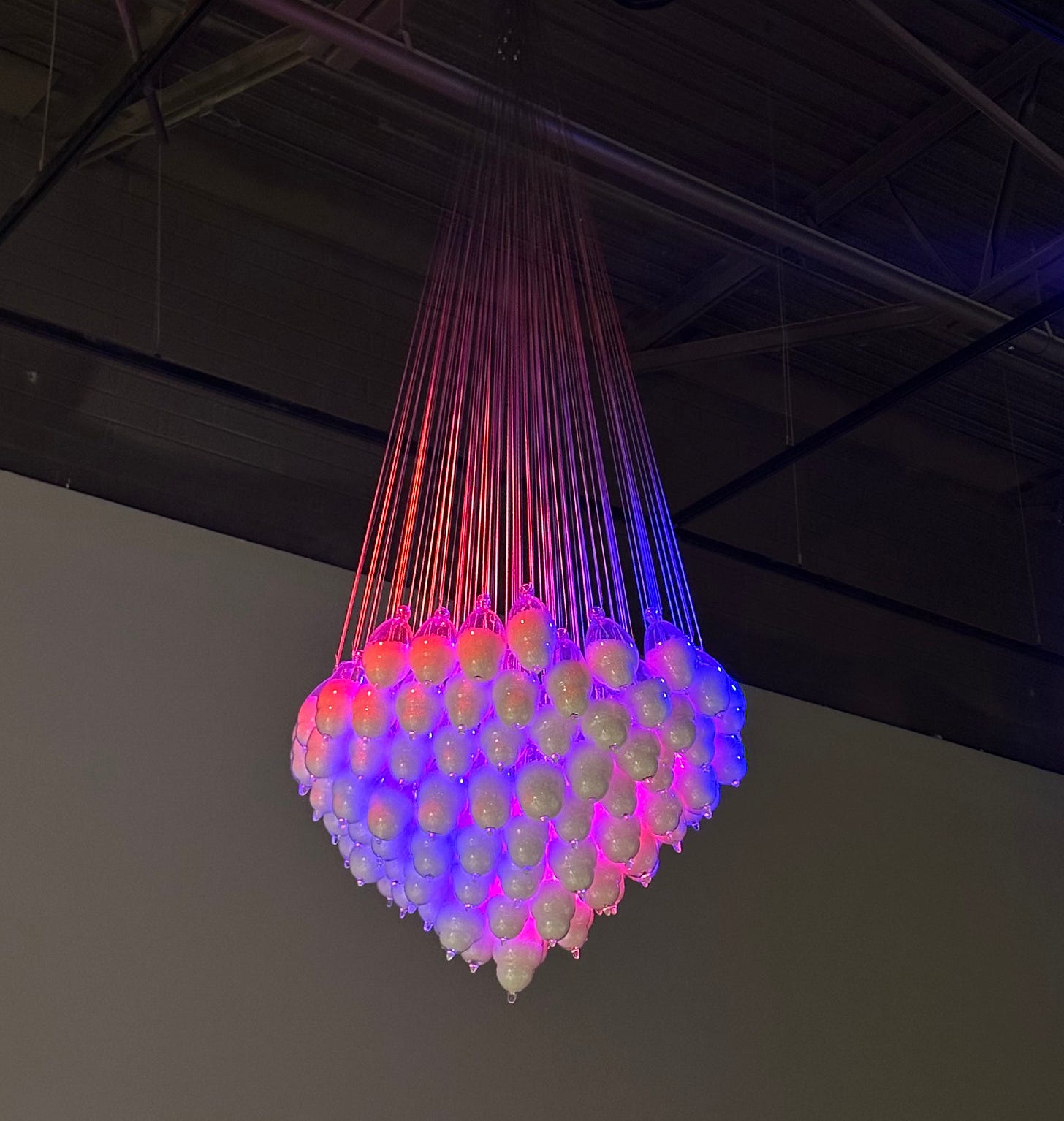Black Women Are God’s Favorite
Simone Leigh's CAAM and LACMA co-presented exhibition proves that.
I've been thinking a lot about Black women. Who we are, how we show up in the world, our beauty, our brilliance, and how we see ourselves and each other. In a world where we're constantly criticized, doubted, mistreated, tried, and harmed, it warms every inch of my being when we're celebrated, honored, cared for, respected, and loved. Not that I'd ever forget, but watching the Olympics has reminded me that we're truly one of one, capable of achieving anything we try, and obviously, God's favorite.
Before celebrating Simone Biles, Rebeca Andrade, Julien Alfred, Sydney McLaughlin-Levrone, Sha'Carri Richardson, Gabby Thomas, and Thea LaFond, to name a few, a Black woman artist reminded me of our history, femininity, and presence as I celebrated the opening of her must-see Los Angeles exhibition. I've admired and have been following Simone Leigh for some time. I discovered her work at her first Los Angeles solo museum exhibition at The Hammer after opting out of spending 2016's Christmas in freezing Chicago. I knew nothing about Leigh or her work, but as soon as I laid eyes on her eyeless sculptures featuring broad noses, full lips, and clusters of rosettes mimicking coiled hair, I knew one thing, she's Black, and I've been fixated on her work ever since. Her unapologetic Blackness is present in every piece, her dedication to centering Black women, emphasizing our bodies and the various ways they've been used for free labor, is profound, and the care she puts into her practice is felt. When I discovered her exhibition was opening during Memorial Day weekend, I set a phone reminder months in advance to ensure I didn't miss it.
On view until January, Simone Leigh's eponymous traveling exhibition organized by the Institute of Contemporary Art/Boston (ICA) is co-presented by the California African American Museum (CAAM) and the Los Angeles County Museum of Art (LACMA). It's the artist's first national tour and features 20 years of her work in ceramics, bronze, and video. Nine works are from her 2022 Venice Biennale presentation, Simone Leigh: Sovereignty, where she represented the United States at what some call the Olympics of the art world as the first Black woman to do so. (Typing "first Black" in 2024 is so cringe.)
On a gloomy Thursday evening a couple of days before “Simone Leigh” officially opened, CAAM held a talk with the artist and the Los Angeles exhibition's curators. I arrived about a half hour before the talk started to view the exhibition before everyone crowded the gallery space. I knew the exhibit was good, I read the reviews, saw photos online, and wanted to take my time as I gazed, read, and took it all in. Upon entering, an 11-foot raffia womblike sculpture topped with a glazed cowrie shell immediately confronts you. During the artist talk, Leigh explained that the figurative form that is recurring throughout her practice is a reference to Mammy's Cupboard, a Mississippi roadside restaurant built in the shape of a "mammy" stereotype where customers enter through the woman's skirt, unbeknownst of the act of violation they're committing while eating inside of a woman's body.

Though it was hard to hear Leigh during the talk due to sound issues and her soft voice, my strained ears caught a few dropped gems. This was obvious to me when I was first introduced to her work, but it was refreshing to hear her confirm that she makes art specifically for Black women. She shared an anecdote about a friend who informed her she had white consumers and how she denied it because she did not want to believe it until she could no longer ignore the fact. When I shared this bit with an art advisor I respect, he said, "That's that Jamaican." To which I responded, "That's that Chicago." Like myself, Leigh was raised in a predominately Black neighborhood on the South Side of the segregated city. When you're raised among those who look like you, you're not encouraged or taught to assimilate to whiteness, and Leigh's over-the-top Blackness displayed in her work proves that.
CAAM and LACMA's presentations are equally breathtakingly beautiful as the work speaks for itself, but I preferred the CAAM installation. With CAAM being a Black institution and LACMA being the largest museum on the West Coast, their patrons are drastically different and so is the overall vibe. CAAM's gallery space is smaller and dimly lit, creating an intimate environment that invites you to linger and engage with the art in a way that the fluorescent lights at LACMA do not provide. Every work was intentionally curated and chosen specially for CAAM's visitors, including a head-turning, gold-painted eight-foot bronze sculpture installed near the entrance. It's as if the works were selected to introduce or educate those who might not know of her practice, while the works at LACMA cater to those who are familiar.
A few of my favorite works from the CAAM presentation are the aforementioned raffia sculpture "Cupboard," 2022, and Kool-Aid, 2011/2023, a chandelier cast from watermelons compromising multiple glass-blown vessels filled with salt and illuminated by colored gels. The vessels feature rounded tips, reflecting a breastlike shape, referencing Black women whose bodies were used as labor to breastfeed the many children they did not birth. A version made from black terracotta and porcelain hangs from the ceiling at LACMA, featuring platinum and gold-glazed nipples and protruding antennas. Its title, Trophallaxis, 2008-2017, references a scientific term that describes the transfer of food from special glands between insects, such as ants or termites.

Another favorite is White Teeth (For Ota Benga), 2001-04, which is a metal case filled with individual glazed toothlike ceramic forms to honor Ota Benga, a young man who was kidnapped from the Congo in 1904 and brought to the United States to be displayed at the Louisiana Purchase Exhibition in St. Louis and later "exhibited" at the Bronx Zoo in 1906. The toothlike forms glazed in various materials, including gold, platinum, and mother-of-pearl, reference Benga's teeth that were filed into sharpened points through ritual practice.
The standout at LACMA is Last Garment, 2022, a bronze-casted sculpture depicting a Black woman bent over, handwashing a clothing item against a rock in a dark pool of water. It references an 1899 photograph of a Jamaican laundress, titled Mammy's Last Garment, taken by a white American male photographer without her consent and circulated as a postcard to lure white tourists to the island, perpetuating a skewed representation of who Black women were, what they did, and how they were seen. Leigh succeeds at dismantling the white male gaze by honoring as opposed to exploiting the history of Black women's labor.

I could blabber about Leigh's artistry and my obsession with how she portrays Black womanhood for days, but I'll spare you. As I approach my creative practice, Leigh reminds me that the key to creating your best work is looking to the past for information, inspiration, and guidance. I know this is basic math for any creative, but sometimes we need to see sculptures of Black women and learn the history behind their creation to give us that push we need to get serious about our creative expression. That's what I love most about art. Not only does it make you think about it, it makes you think about you.





What a beautiful ode to Black women through the lens is visual art. Loved every bit of this and I’m gonna make seeing Leigh’s work irl a priority. Can’t wait to read more from you!